Research on the Evolution and Conservation of Endangered Plants
- Past and Present Mass Extinctions
- Dryopteris shibipedis
- Miniature Plants of Amami
- Potamogeton lucens
- Orchids
- Investigating the Causes of Rarity in Nervilia nipponica Makino
- Epiphytic Plants of Japan
- Understanding the Status of Endangered Plants Distributed in the Ryukyu Islands
- Research to Reintroduce the Extinct-in-the-Wild Species Eriocaulon heleocharioides Satake
- Exploring Flower-Insect Interactions with a Focus on Endangered Plants
Past and Present Mass Extinctions
The birth and extinction of organisms are natural aspects of life. Fossil data show that five major mass extinctions have occurred over the past several hundred million years. The largest of these took place at the end of the Permian period. At the end of the Cretaceous period, mass extinction events included the disappearance of the dinosaurs, which is believed to have been caused by climate changes resulting from an asteroid impact. In this way, changes on Earth had a profound impact on the organisms of the time. Even outside of mass extinctions, species have repeatedly gone extinct.
Today, however, human activities are severely damaging the environments in which plants grow, and overexploitation has placed many species at risk of extinction, with some already lost forever. Of the approximately 7,000 species of vascular plants in Japan, including varieties and subspecies, about a quarter, 1,700 species, are classified as endangered. If current trends continue, it is estimated that plants are heading toward extinction at a rate 100 to 1,000 times faster than natural background extinction.
At the Tsukuba Botanical Garden, we conduct research to clarify the evolutionary characteristics of plants that are currently at risk of extinction. Here are some examples. This research is part of the results from the National Museum of Nature and Science’s Priority "Research on Endangered Plants in Japan" and Basic "Research on the Identity and Origins of Japan’s Endemic and Narrowly Distributed Species."
Dryopteris shibipedis
This fern, which once grew only at the foot of Mount Shibi in Kagoshima Prefecture, is now considered extinct in the wild. However, a few individuals had been preserved at the Tsukuba Botanical Garden. The fern reproduces asexually through apogamy and was long thought to be a hybrid resulting from the cross of another species. Molecular phylogenetic analysis has revealed that it likely arose multiple times as a hybrid between Dryopteris kinkiensis and Dryopteris pacifica (Nakai) Tagawa.
Efforts are also being made to propagate the Dryopteris shibipedis Sa. Kurata specimens preserved at the botanical garden. The next generation of Dryopteris shibipedis Sa. Kurata propagated from spores now consists of more than 50 healthy plants, and the immediate risk of extinction can be considered avoided.
 Dryopteris shibipedis
Dryopteris shibipedis
Miniature Plants of Amami
Several miniature plant species are known from Amami Oshima, some of which are at risk of extinction. While the leaves of related ferns can reach several tens of centimeters in length, the Odontosoria minutula are only a few centimeters long or less. This rare species is known to grow in only one river on Amami Oshima. Polystichum obae is another rare species native to Amami Oshima. This fern belongs to the Polystichum and, like Polystichum inaense and other small species, is miniature in size. Molecular phylogenetic analysis has revealed that it is closely related to larger species of Polystichum. Identifying the parent species of miniature plants could provide clues to how miniaturization and speciation occurred.
Lysimachia liukiuensis Hatus (Primulaceae) is another miniature species endemic to Amami. Research suggests that it differentiated on the isolated Amami Oshima in response to past geological connections and separations between islands and the continent, and between islands within the Ryukyu Islands.
 Odontosoria minutula
Odontosoria minutula  Polystichum obae
Polystichum obae Potamogeton lucens
This aquatic plant once had a wide distribution from central Honshu to Kyushu, but it now remains in only one location in northern Kyushu. Its natural habitats were destroyed due to the reclamation of lakes and ponds. Interestingly, it reappeared in a pond created by construction at Lake Teganuma in Chiba Prefecture, where it had previously grown. Seeds buried in the soil had germinated. Using these buried seeds, efforts are being made to revive Potamogeton lucens.
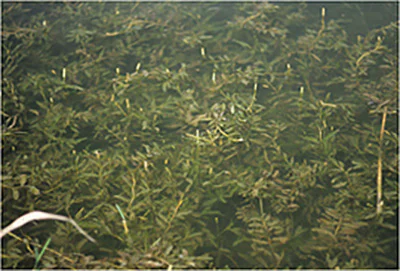 Potamogeton lucens
Potamogeton lucens  Flower of Potamogeton lucens
Flower of Potamogeton lucens Orchids
Orchids are among the most threatened plants due to overcollection and habitat destruction. About 200 species, roughly two-thirds of Japan’s native orchids, are at risk of extinction. Orchids form symbiotic relationships with fungi, which are essential for their survival. Research has shown that Epipactis helleborine var. sayekiana obtains nutrients from fungi associated with the roots of black pine (Pinus thunbergii Parl). In other words, Epipactis helleborine var. sayekiana can only survive in black pine forests. Many orchids are epiphytic plants that grow on trees, so when the forests that support them are destroyed, they are driven to the brink of extinction. We are conducting research to unravel the evolution of orchid symbiosis and epiphytism.
Investigating the Causes of Rarity in Nervilia nipponica Makino
Nervilia nipponica Makino is a perennial orchid with very few natural populations, mainly in western Japan. Research into the causes of its rarity has shown that it likely cannot germinate or grow from seeds without a symbiotic relationship with a specific fungus. However, the taxonomic classification of this fungus remains unknown. Because it does not match any fungus known worldwide, it is thought that the rarity of this fungus limits the distribution of Nervilia nipponica Makino. To save Nervilia nipponica Makino from extinction, it is essential to clarify the characteristics of this mysterious fungus.
 Flower of Nervilia nipponica Makino
Flower of Nervilia nipponica Makino Epiphytic Plants of Japan
Epiphytic plants live in unusual habitats, growing on trees. While most species are found in the tropics, Japan also has its own native epiphytic plants. Among Japan’s seed plants, about 50 species are epiphytic, and 80% of them are classified as endangered. When the forests that support them are destroyed, epiphytic plants lose their habitats. Many species grow on large, old trees, so the long-term protection of ancient forests is essential for their conservation.
We focus on Japan’s endemic and endangered epiphytic species, such as Liparis fujisanensis, Liparis truncata F. Maek. ex T. Hashim., and Vaccinium yakushimense. By identifying their closely related terrestrial species, we investigate what characteristics differentiate epiphytic species from their terrestrial relatives and how these changes enabled them to live on trees. In Liparis fujisanensis, the fungal partners differ from those of closely related terrestrial species. Research has shown that changes in fungal partners have a significant impact on plant growth, suggesting that shifts in fungal associations may have played a role in the evolution of epiphytism.
 Liparis fujisanensis growing on trees
Liparis fujisanensis growing on trees Understanding the Status of Endangered Plants Distributed in the Ryukyu Islands
Japan is one of the regions with the highest density of endangered plants in the world. In particular, the Ryukyu Islands, along with the Ogasawara Islands, are areas where endangered plants are highly concentrated. However, research on the phylogenetic classification of plants in the Ryukyu Islands remains insufficient. Many endangered plants are thought to be unknown to us, and the classification and origins of numerous endangered species are still unclear. At the Tsukuba Botanical Garden, we conduct phylogenetic and taxonomic research on these endangered plants.
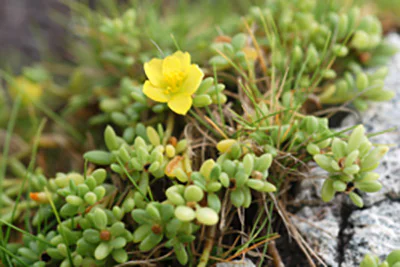 Newly Described Amami Matsubabotan (Portulaca okinawensis E.Walker et Tawada var. amamiensis Kokubug., Koh Nakam. et Yokota)
Newly Described Amami Matsubabotan (Portulaca okinawensis E.Walker et Tawada var. amamiensis Kokubug., Koh Nakam. et Yokota) Research to Reintroduce the Extinct-in-the-Wild Species Eriocaulon heleocharioides Satake
Eriocaulon heleocharioides Satake disappeared in 1994 after changes in water management at its only natural habitat, Sanuma in Shimotsuma City, Ibaraki Prefecture. Since then, it has been preserved only in botanical gardens and other controlled environments as an extinct-in-the-wild species. Since 2008, the Tsukuba Botanical Garden of the National Museum of Nature and Science has been conducting a conservation research project to reintroduce Eriocaulon heleocharioides Satake to the wild.
Through efforts that included (i) restoring water level management and aquatic conditions to their pre-extinction state, (ii) establishing systems for seed preservation and propagation, and (iii) studying habitat conditions as well as pollination and reproductive traits, Eriocaulon heleocharioides Satake flowered and produced seeds in its natural habitat in 2009, for the first time in 16 years. Since then, conservation research has continued with the goal of establishing a self-sustaining wild population.
At Sanuma in Shimotsuma City, Ibaraki Prefecture, the reintroduction site, individuals are spreading beyond the areas where seeds were sown. However, annual fluctuations are considerable, and it may take more time before a truly self-sustaining wild population is established.
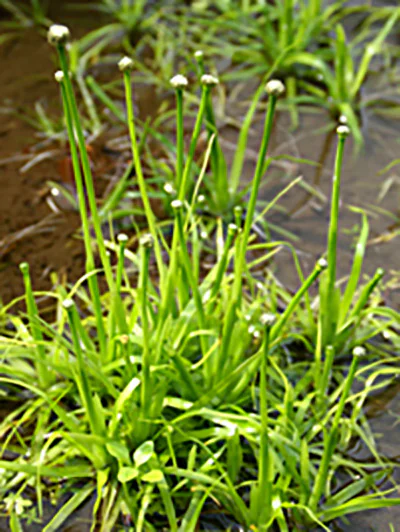 Eriocaulon heleocharioides Satake (Eriocaulaceae)
Eriocaulon heleocharioides Satake (Eriocaulaceae)
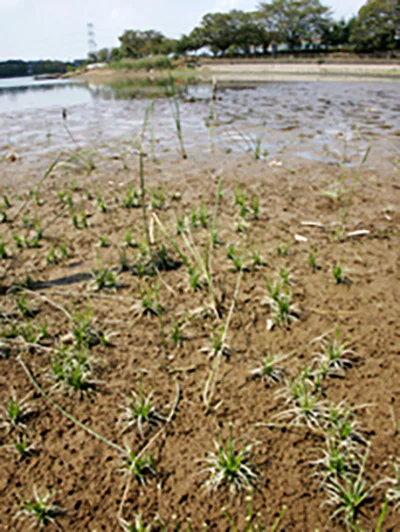 Eriocaulon heleocharioides Satake at the Reintroduction Site, Sanuma, Shimotsuma City, Ibaraki Prefecture
Eriocaulon heleocharioides Satake at the Reintroduction Site, Sanuma, Shimotsuma City, Ibaraki Prefecture
Exploring Flower-Insect Interactions with a Focus on Endangered Plants
Most angiosperms, or flowering plants, rely on animals, called pollinators, to transfer pollen and ensure successful seed production and reproduction. Moreover, in many plant species, pollinators are not interchangeable; reproduction often depends on a highly specific set of partners.
However, information on which pollinators individual plant species depend on is extremely limited. Even for wild plants in Japan, where basic research is relatively advanced, information on how plants are pollinated is still fragmentary. The value of such basic information is becoming increasingly important for the conservation of Japan’s plant species, many of which are currently at critical risk.
Accordingly, we are steadily compiling information on which pollinators individual plant species rely on for reproduction, focusing especially on endangered and endemic plants in Japan. Such knowledge helps us understand more broadly how interactions among living organisms, including humans, foster biodiversity. It also provides important guidance for developing conservation strategies for individual plant species that are at risk of extinction.
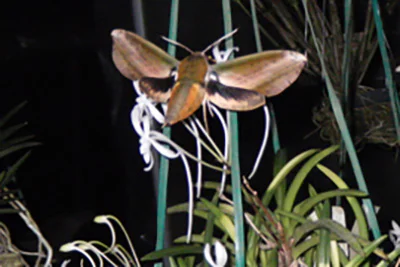 Pollinator Visiting Neofinetia falcata: Theretra nessus
Pollinator Visiting Neofinetia falcata: Theretra nessus